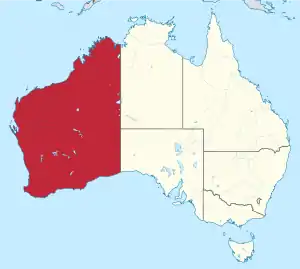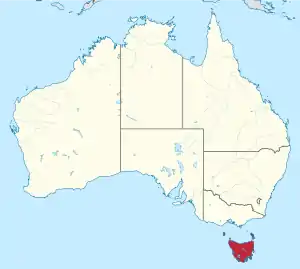Secession in Australia
This article relates to historical and current separatist movements within Australia. Separatism conventionally refers to full political separation, including secessionism; groups simply seeking greater autonomy are not separatist as such.[1]
List of movements
Western Australia
Various attempts for secession have occurred in Western Australia, including the 1933 Western Australian secession referendum, and a number of more recent movements have continued proposing and pushing for independence, including the Western Australia Secessionist Movement [2]
Murrawarri Republic
Murrawarri Republic is a micronation in Australia created by an ethnic/racial Indigenous group that has been pushing for independence of Indigenous Australians.[3][4]
Euahlayi Peoples Republic
The Euahlayi Peoples Republic is an Aborginal micronation that declared independence from Australia in 2013.[4]
Republic of Mbarbaram
The Republic of Mbarbaram is an Aborginal micronation that declared independence from Australia in 2013.[4]
Wiradjuri Central West Republic
The Wiradjuri Central West Republic is an Aborginal micronation that declared independence from Australia in 2014.[4]
Sovereign Yidinji government
The Sovereign Yidinji government is an Aborginal micronation that declared independence from Australia in 2014.[4]
Yuggera Ugarapul Tribal People's
The Yuggera Ugarapul Tribal People's declared their independence from Australia in 2016.[4]
Mirrabooka Sovereign United Nations
In 2017 The Mirrabooka Sovereign United Nations formed[4]
Indigenous Australians
Various proposals have been created to grant Indigenous Australians their own ethnostate, and have also proposed additional autonomous for aboriginal groups that hold native title land over various areas of Australia. The Aboriginal Tent Embassy has demanded that the government give Aboriginals control of the Northern Territory as a state, mining rights to all aboriginal reserve lands and settlements, compensation money for lands not returnable to take the form of a down-payment of A$6 Billion and an annual percentage of the gross national income.
Tasmania
Tasmania, historically an independent colony which joined the Commonwealth of Australia which has had various support groups that have proposed secessionism in Tasmania, with Labor Premier Doug Lowe and Liberal Premier Robin Gray seriously considered secession.[5] In the 1990s the First Party of Tasmania was formed, which aimed for Tasmanian secession.
Victoria
The first Victorian independence movement arose in 2021.[6] Calls for independence began in the wake of the COVID-19 pandemic in Australia, which had significantly disrupted normal interstate relations through border closures and health restrictions. The mascot of the Victorian Independence Movement is a navy blue Fairy penguin with a white 'v' on its chest. No polling has yet been undertaken to assess the popularity of the independence movement in Victoria.
References
- Doyle, Don (2010). Secession as an International Phenomenon. University of Georgia Press. ISBN 9-780-8203-3008-2. Archived from the original on 19 October 2020. Retrieved 16 October 2020.
- "Western Australia Secessionist Movement".
- Neubauer, Ian Lloyd (30 May 2013). "Australia's Aborigines Launch a Bold Legal Push for Independence". Time magazine. Retrieved 23 July 2013.
- Spirits, Jens Korff, Creative (10 March 2020). "Aboriginal nations declaring independence". Creative Spirits. Retrieved 21 September 2023.
{{cite web}}: CS1 maint: multiple names: authors list (link) - Watson., Reg. A. (September 2013). "The case for complete independence for Tasmania". Archived from the original on 29 August 2013. Retrieved 28 February 2020.
- "(no title)". vicindependence.com. 27 July 2022. Retrieved 30 May 2023.
{{cite web}}: Cite uses generic title (help)

